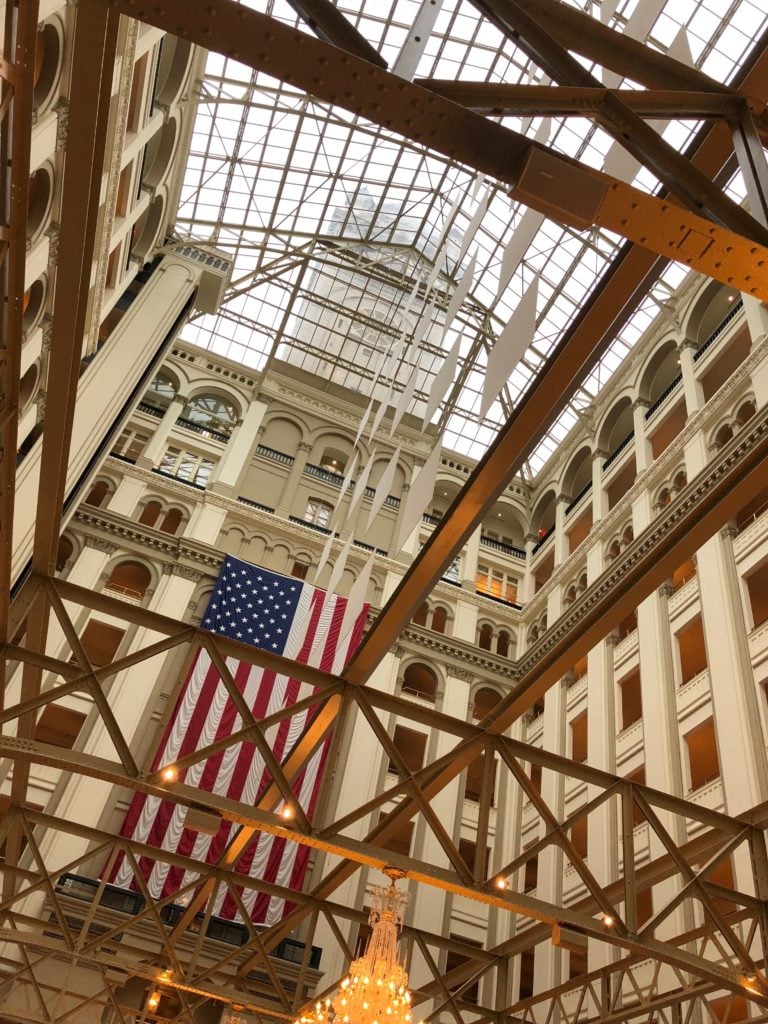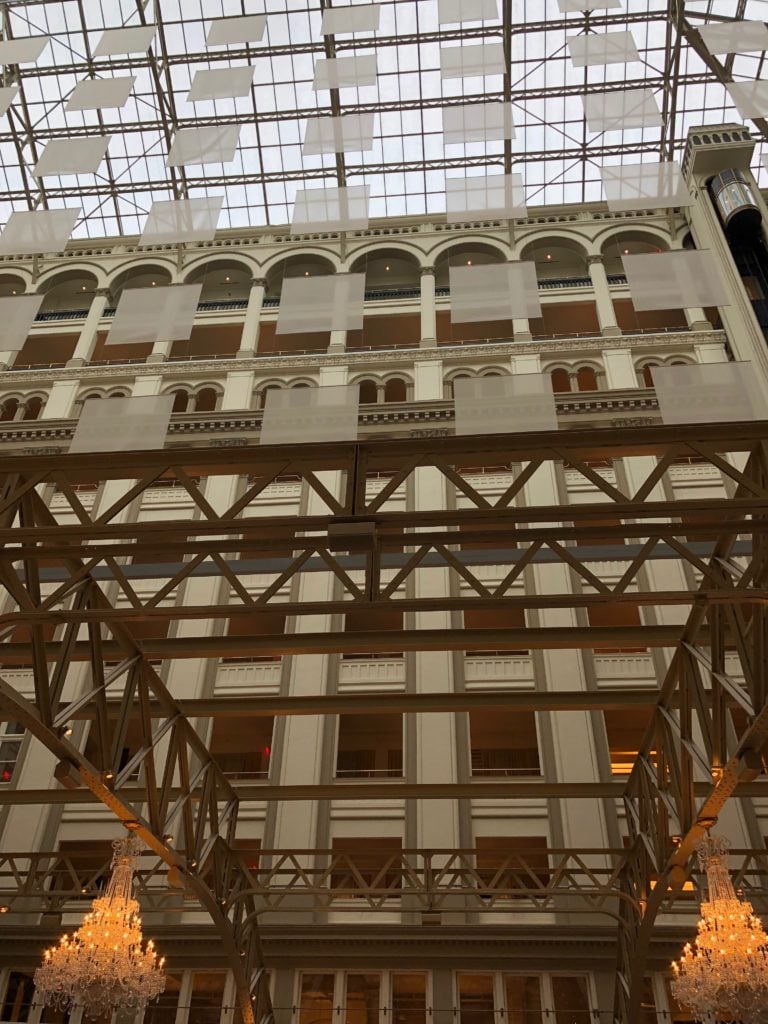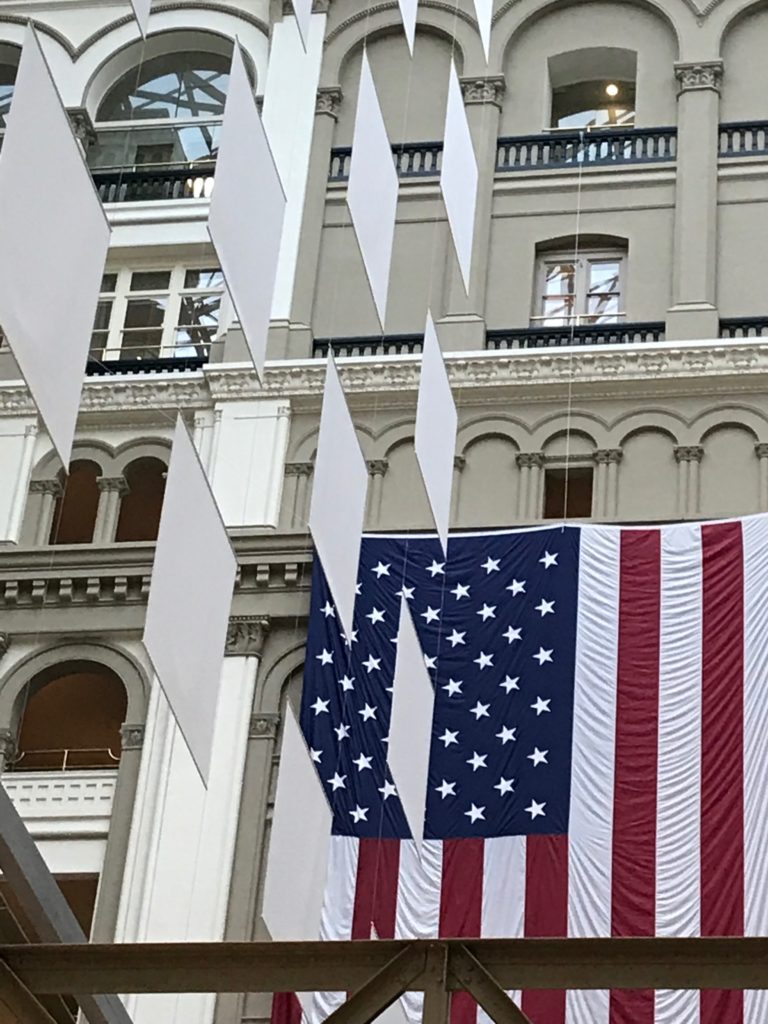Art World
Did Donald Trump Ruin a High-Concept Artistic Masterwork Inside His DC Hotel?
Trump International's chandeliers, TVs, and American flag may be stripping Robert Irwin's historic installation of its understated power.

Trump International's chandeliers, TVs, and American flag may be stripping Robert Irwin's historic installation of its understated power.

Tim Schneider

Short of tricking an order of Franciscan monks into a tour of Graceland, it would be difficult to generate a more extreme clash of aesthetics than the one now on view inside the atrium of the Trump International hotel in Washington, DC. There, in a striking display of visual dissonance, visitors will find Robert Irwin’s elegant site-conditioned installation 48 Shadow Planes.
Or at least, they’ll find it if they look hard enough. Because Trump’s taste for brute-force bombast has now created a sensory overload that Irwin’s work was never conceived to overcome.
The origin of this cosmically mismatched pairing speaks to why the public sector increasingly can’t have nice things. Completed in 1983, 48 Shadow Planes counts among scores of works funded to date by the US General Services Administration’s Art in Architecture Program. Similar to (but predating) New York’s Percent for Art initiative, the program funnels .5 percent of estimated construction costs for every American federal building into public artwork for the project in question.
However, historical circumstances have placed Irwin’s piece, both literally and symbolically, in a position that no reasonable human would have anticipated decades ago—and raised several questions about culture, politics, and their collision in the process.

Robert Irwin’s 48 Shadow Planes in the Trump International hotel, Washington, DC. Courtesy of the Goldstein family.
Although the perpetual tidal wave of foreign dignitaries and domestic ring-kissers sweeping through the property since November 9, 2016, might make it tempting to classify the Trump International as a quasi-federal building befitting a quasi-federal executive, the building spent generations after its 1899 completion fulfilling legitimate government roles.
The first was to simultaneously headquarter the US Post Office Department and serve as the district’s actual postal hub at the turn of the 20th century. Later, the Old Post Office Building, as it has been known for most of its history (even after losing its mail-related responsibilities), temporarily hosted the National Endowment for the Arts, the National Endowment for the Humanities, and a range of other respected civic entities.
However, the colossal size of the granite-clad, Romanesque Revival building—its footprint comprises an entire city block, and its clock tower rises 315 feet above Pennsylvania Avenue—brought colossal maintenance costs with it. The demanding economics of preservation compelled officials to begin converting the Old Post Office into a mixed-use building in 1977. The plan was for the retail spaces on the lower level to offset the upkeep expenses while federal government offices remained active on the floors above.
GSA commissioned Irwin in the midst of this conversion/renovation, awarding him the challenge of devising a work able to hold the giant atrium with the financial equivalent of a baby’s hand: a budget under $50,000.
Irwin rose to the occasion by running six lines of cable across the atrium, each one flying eight rectangles of semi-translucent white scrim. The artist later described his concept by saying, “The building’s interior is all windows. My work creates another layer of windows suspended in space.” Their effect was to reassert the overlooked wonder of everyday phenomena.
The “shadow planes” earn their name by capturing the ever-shifting architectural silhouettes cast by the sun as it arcs above the atrium’s skylight each day, making them perpetually dynamic abstract compositions. The scrim also acts like a canvas on which the changing temperature of sunlight becomes more noticeable.
Even the scrim’s materiality seems to shift. As Lawrence Weschler, author of the definitive Irwin book Seeing Is Forgetting the Name of the Thing One Sees, explained to artnet News, “At some times of day it was translucent. At other times it was almost opaque.”
Scrim has gone on to become one of Irwin’s signature materials. In succeeding years, it has played a pivotal role in such major works as Excursus: Homage to the Square3 (2015) at Dia and a new untitled installation at Sprüth Magers’s Los Angeles space, now on view until late April.
Although he emphasized that Irwin “will always claim he wasn’t a political artist,” Weschler said, “To me, [48 Shadow Planes] felt like a very civic piece… This was not a case where an artist aggressively intervened in the space.” Instead, Irwin executed a sophisticated minimalist gesture that “made [the building’s] civic meaning luminous.”
The only problem was that Irwin’s lyrical, low-cost masterstroke couldn’t single-handedly keep the property around it solvent. When the mixed-use conversion failed in that task, too, officials decided that the best way to save the building would be to lease it as a hotel.

Robert Irwin’s 48 Shadow Planes hidden by decorations. Courtesy of the Goldstein family.
In 2013, the Trump Organization signed the lease that would transform much of the Old Post Office Building (renamed the Nancy Hanks Center in 1983) into the 263-room Trump International hotel. While the architecture itself was protected by both an individual listing on the National Register and its status as a contributing building within the Pennsylvania Avenue National Historic Site, Irwin’s work lacked any such bureaucratic armor.
Weschler notes that, for 48 Shadow Planes, renting the Old Post Office “raises all kinds of issues that would have been raised even if it weren’t Trump” who ended up on the lease. But ironically, Irwin’s work initially benefited from the tenancy change.
The Old Post Office became the Trump International courtesy of a $200 million makeover—one that gave GSA its first chance to properly examine and restore 48 Shadow Planes, whose exposure to 30 consecutive years’ worth of dust, dirt, and other daily irritants had turned the scrim a color that might best be dubbed Tobacco Lung.
Working with Irwin and the McKay Lodge Art Conservation Laboratory, GSA undertook an extensive treatment of the piece between February 2014 and August 2016. All 48 scrims were replaced. Significant structural elements were upgraded. Cosmetic degradations were remedied. All told, GSA confirmed that the process cost roughly $400,000, a sum borne entirely by the federal government.
The less uplifting news is that the Trump Organization’s lease appears to have granted the hotel relatively wide latitude to choose the décor for the environment on all sides of the restored 48 Shadow Planes.
Today, this has primarily translated into the insertion of several gaudy crystal chandeliers between the work and the floor below, as well as a behemoth American flag hanging inside the atrium from the moulding perpendicular to Irwin’s grid. A massive display of bottles and flat-screen TVs in the bar & lounge below—named the Benjamin, as in “Franklin”—doesn’t exactly massage aloe into these other wounds.
For viewers, the end result is something like trying to appreciate a Philip Glass composition played while a Mardi Gras parade surges around the lone pianist. In one sense, the work itself is intact, but the context has become so cacophonous that it swallows up much of the intended effect.
The dilemma is whether Trump’s maximalist pastiche of faux glamour and all-too-real nationalism pushes 48 Shadow Planes past the point of no return.

Robert Irwin’s 48 Shadow Planes in the Trump International hotel, Washington, DC. Courtesy of the Goldstein family.
In contemplating the question, Weschler was careful to draw a distinction between “site-specific” works and Irwin’s more nuanced “site-conditioned” works. For the latter, even if the site itself (the building or the space) remains consistent, a change to its conditions, such as the surrounding décor and its impact on sight lines or lighting, can invalidate the piece.
This leaves him thoughtfully ambivalent about the verdict. “At the moment, what was glorious about the piece has been compromised,” he says. “To argue it the other way, the civic virtue of that piece is possibly now part of the Resistance. It may carry forth the memory of the building in its early years.”
In his view, only one judge could definitively rule on the matter. After referencing James Turrell’s decision to declare Tending (Blue), his Skyspace at the Nasher Sculpture Center, “destroyed” by the erection of a condo tower permanently visible through its ceiling aperture, Weschler put it this way: “Has [48 Shadow Planes] been so destroyed by the kitschiness of the flag and the chandeliers? That’s a question for Bob.”
We may never know the answer. A representative from Pace Gallery informed artnet News that Irwin, who will turn 90 in September, would not be available for an interview. The gallery declined to comment further on the 48 Shadow Planes predicament.
Other involved parties chose not to weigh in on the matter, either. After asking for a set of questions to be emailed over, the Trump International did not respond by publication time.
GSA was only slightly more forthcoming. A representative responded to several inquiries about specific unknowns relating to the piece with the following written statement: “The artwork 48 Shadow Planes remains in federal custody and GSA maintains responsibility for the conservation of the art. The piece was conserved and reinstalled in the Old Post Office Building.”
All of which leaves Weschler with the last word, whether he likes it or not. Rather than speak for Irwin, though, he may have provided the most insight by speaking from his deep experience of the artist.
Above all, he said, “Bob is an artist of presence. One of the things he talks about in Seeing Is Forgetting… is that art in the moment of creation is a present thing, and then it becomes a historical thing. And he’s not interested in a historical thing… He brings [his pieces] to a moment of perfection, and then time moves on.”
Should the art world choose to do the same, though? “At some level, we’re dealing with comedy here and not tragedy,” he says in summation.
In other words, coupled with the prospect that Irwin truly may not care, the dissonance between Irwin and Trump is so extreme that it elevates the pairing to the realm of the absurd. If monks do ever end up in Graceland, maybe they’ll just laugh about it.